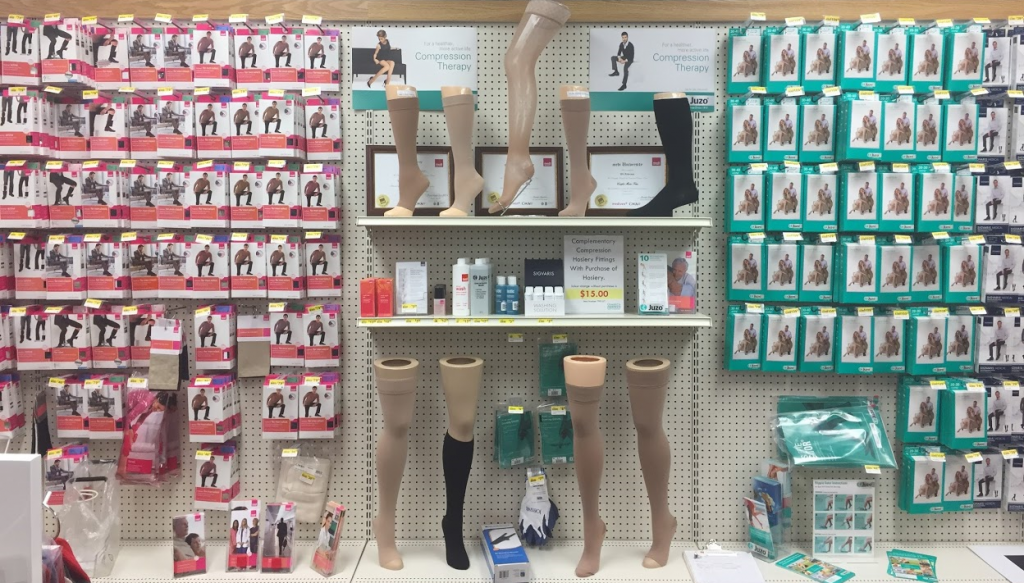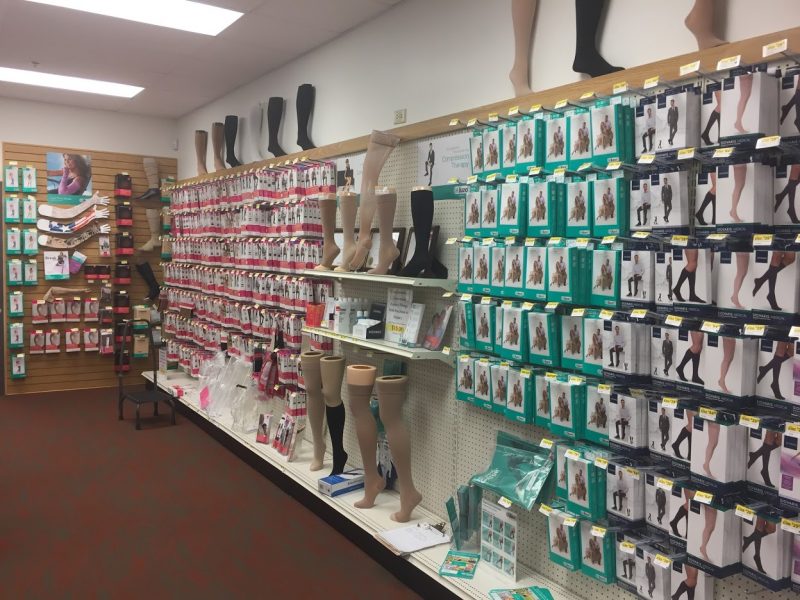Best Compression Hosiery Practices
Compression hosiery is becoming something of a household name—even if you don’t know what it is. People from opposite ends of the spectrum, distance runners to emergency vein surgery candidates, are learning about the benefits of compression. Best compression hosiery practices when buying stockings for the first time can be hard to come by.
You might be asking yourself how one product can be so versatile or maybe even ‘could I benefit from this?’ There are a few things to go over before you will be able to answer those questions, so let’s take a look at compression hosiery in general.
What is Compression Hosiery Used for?
There are many conditions that can benefit from compression hosiery. Some of the most common conditions that can benefit from compression hosiery include venous insufficiency, venous thromboembolism, swelling due to flying, varicose veins (including spider-veins and pregnancy-related vein issues), edema, and just plain old tired, aching legs. Competitive athletes can also use compression to keep their legs fresh!
All of the mentioned conditions benefit from increased blood flow, keeping the veins compressed and working hard. Simply being on your feet for the majority of a working day can tire your legs out—compression hosiery can even help with this!
How Does Compression Hosiery Work?
The name of the product may give it away, but compression hosiery works by, well, compressing. Compression hosiery is essentially an elastic garment used to control swelling and stimulate blood flow in a user’s legs. The compression in the hosiery is tightest at the ankle, gradually decreasing the higher the garment goes.
Compression hosiery is not one-size-fits-all, contrary to being elastic. In fact, compression hosiery can be very difficult to size for. Complications can arise from hosiery that is too loose or too tight. Too loose and the compression isn’t doing what it needs to. Too tight and you’re risking loss of circulation, potentially even negatively affecting the issue you’re trying to alleviate!

OK, so how do I Know What Size is Best?
Every compression hosiery brand has a different sizing chart, so most of the time a traditional ‘small, medium, large’ mindset isn’t going to work (although some low compression can be selected based on shoe size). Knowing where to measure on your leg is essential when sizing for a pair of hosiery. This is not enough, though!
When to measure is another very important factor to consider when measuring for compression hosiery. The longer you are on your feet, the more your legs are going to swell. The best time to be measured for compression hosiery is actually the moment you step out of bed.
Why this is so important is actually a very simple answer. Compression hosiery prevents swelling. If you get measured when your legs are already swollen, how will the compression ever work? You want hosiery that prevents swelling, not an expensive sock.
Ready to Measure?
OK, it’s early in the morning and you are ready to measure yourself (or someone else) for hosiery. What are the steps to get good measurements?
- Have a tape measure with both inches and centimeters on hand.
- Get a pad of paper ready with two columns, one for each leg.
- Remember to record every measurement in both in and cm!
- Measure around each ankle, at the narrowest point.
- Measure around each calf, at the widest point.
- For a knee-high length measurement, sit with your legs at a 90-degree angle and measure from the bottom of your foot to the bend in your knee (not the top of your knee or kneecap—that is too far!).
- If you need thigh-high compression, measure around each thigh, at the widest point (usually under the buttocks by approx. 2-4”).
- For a thigh-high length measurement, stand up straight and measure from the bottom of your foot to the bottom of your buttocks.
- If you need waist-high compression, take one measurement around the hips at the widest point
- Did you measure in both in and cm?
We have created a PDF file that you can print out or save on your phone to help when sizing:
How to Measure for Compression PDF
What Type of Compression Hosiery do I Need?
If you have been prescribed compression hosiery by a doctor, the prescription will usually have a number on it that looks like 8-15 or 15-20. This is the strength of hosiery, measured in mmHg or millimeter of mercury. Basically, what this means is how tight the hosiery will be. If you saw a doctor and he or she did not say what strength of compression to get, you need to call the office and get an answer—doctors are very specific with what hosiery they want you in.
If you did not see a doctor, but still want or need compression hosiery, you must look at what symptoms you want to alleviate. There are 4 ‘main’ compression strengths (there are more, but they are not used like the ‘big’ 4).
- 8-15mmHg—used for minor vein and swelling problems. 8-15 hosiery is great for people who experience minor discomfort from lots of standing or swelling due to flying.
- 15-20mmHg—a longer term solution, 15-20mmHg is used when vein issues start to become noticeable. Frequent flyers or people who are always on their feet should start here.
- 20-30mmHg—a much tighter compression, 20-30mmHg is the go-to for athletes, as it holds up against the beating sports delivers to the legs. 20-30mmHg is also a good range for those looking to prevent swelling due to edema or lymphedema.
- 30-40mmHg—a heavy duty option, 30-40mmHg compression is used for severe swelling and circulation issues. Many doctors will prescribe 30-40mmHg compression after vein surgery as a short-term way to keep everything in place. 30-40mmHg is very difficult to put on and take off, so please let your doctor know if you have any trouble with lesser compression or even pantyhose.
What do I Look for Now?
After you have measured yourself and figured out which size and compression level you need(size and compression are the most important part), it’s time to pick out some things you want. There are many brands of compression, all of which have their own styles and features.
Here are a few of the popular compression hosiery options:
- Band styles. Compression hosiery can be uncomfortable—it is essentially squeezing your legs really hard. Band styles are the options added to the top of hosiery. Do you like the feel of beads or a continuous band? Do you like lace or solid fabric? Are you allergic to silicone? All of these and more are questions that can be answered when you look at specific brand options.
- Most compression hosiery manufacturers offer different lines of hosiery under their brand name. These lines differentiate from one another by being composed of different fabrics. Do you like light fabric or heavy? Opaque or sheer? Silk or cloth? More questions you can answer by looking at all the brands available at your local retailer.
- Open toe or closed toe? An open toe stocking is something that bugs many people. It feels different than regular socks, so what are the advantages? The main advantage open toe stockings provide is that they are easier to get on! You can use any frictionless material to help put on stockings—simply pull the material out of the bottom when you are ready.
- Many of the top compression hosiery brands offer some lines that have a bit of style. Do you prefer certain colors or designs? Check out what each manufacturer has to offer—just make sure the style you like is also the stocking you need!
Putting on Compression Hosiery
If compression hosiery is so great, how come not everyone uses it? This question is very simple—because it is much more difficult to put on a pair of compression stockings than it is regular socks. The higher the compression (mmHg), the more difficult the garment is going to be to put on.
We have put together a video for you to check out. This video is done by Alecia, one of our long-time, certified fitters. Alecia is also a long-time daily user of 20-30 knee high compression hosiery.
If your legs are not cooperating or you have severe swelling/vein issues, you should probably set up an appointment with a certified compression expert. Luckily we have 6 certified fitters on staff! We even have a selection of stocking donning aids if you are having difficulty putting on hosiery.
If you are having difficulty with any part of the compression stocking process, please don’t hesitate to call us! We are open 7 days a week and always have certified staff on hand. Start practicing best compression hosiery methods with our help!


